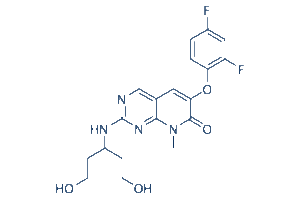Pamapimod
This product is for research use only, not for human use. We do not sell to patients.

For small sizes, please check our retail website as below: www.invivochem.com
| Size | Price | Stock |
|---|---|---|
| 250mg | $1550 | To Be Confirmed |
| 500mg | $2200 | To Be Confirmed |
| 1g | $3300 | To Be Confirmed |
Cat #: V2663 CAS #: 449811-01-2 Purity ≥ 98%
Description: Pamapimod (formerly known as R-1503; Ro-4402257) is a novel and selective inhibitor of p38 mitogen-activated protein kinase (MAPK) with immunomodulatory and anti-inflammatory effects.
Top Publications Citing Invivochem Products
Publications Citing InvivoChem Products
Product Promise

- Physicochemical and Storage Information
- Protocol
- Related Biological Data
- Stock Solution Preparation
- Quality Control Documentation
| Molecular Weight (MW) | 406.38 |
|---|---|
| Molecular Formula | C19H20F2N4O4 |
| CAS No. | 449811-01-2 |
| Storage | -20℃ for 3 years in powder formr |
| -80℃ for 2 years in solvent | |
| Solubility In Vitro | DMSO: 81 mg/mL (199.3 mM)r |
| Water: <1 mg/mLr | |
| Ethanol: 28 mg/mL (68.9 mM) | |
| SMILES Code | O=C1C(OC2=CC=C(F)C=C2F)=CC3=CN=C(NC(CCO)CCO)N=C3N1C |
| Synonyms | R1503; R-1503; R 1503; Ro 4402257; Ro-4402257; Ro 4402257. |
| Protocol | In Vitro | After lipopolysaccharide (LPS) stimulation of the human myelomonocytic cell line (THP-1), secretion of TNF-α is inhibited by Pamapimod, with an EC50 of 25 nM. Pamapimod suppresses TNF-α and IL-1β production in whole blood, with EC50 values of 0.40 and 0.10 μM, respectively. Pamapimod binds to JNK kinases with Ki values of 190 nM, 16 nM and 19 nM for Jnk1, Jnk2 and Jnk3, respectively. |
|---|---|---|
| In Vivo | Pamapimod (0-150 mg/kg; oral gavage; once daily; DBA/1J female mice) treatment reduces inflammation and bone loss in murine collagen-induced arthritis. |
These protocols are for reference only. InvivoChem does not
independently validate these methods.
| Solvent volume to be added | Mass (the weight of a compound) | |||
|---|---|---|---|---|
| Mother liquor concentration | 1mg | 5mg | 10mg | 20mg |
| 1mM | 2.4608 mL | 12.3038 mL | 24.6075 mL | 49.2150 mL |
| 5mM | 0.4922 mL | 2.4608 mL | 4.9215 mL | 9.8430 mL |
| 10mM | 0.2461 mL | 1.2304 mL | 2.4608 mL | 4.9215 mL |
| 20mM | 0.1230 mL | 0.6152 mL | 1.2304 mL | 2.4608 mL |
The molarity calculator equation
Mass(g) = Concentration(mol/L) × Volume(L) × Molecular Weight(g/mol)
Mass
=
Concentration
×
Volume
×
Molecular Weight*
The dilution calculator equation
Concentration(start)
×
Volume(start)
=
Concentration(final)
×
Volume(final)
This equation is commonly abbreviated as: C1 V1 = C2 V2
Concentration(start)
C1
×
Volume(start)
V1
=
Concentration(final)
C2
×
Volume(final)
V2
Step One: Enter information below
Dosage mg/kg
Average weight of animals g
Dosing volume per animal µL
Number of animals
Step Two: Enter the in vivo formulation
%DMSO
+
%
+
%Tween 80
+
%ddH2O
Calculation Results:
Working concentration:
mg/ml;
Method for preparing DMSO master liquid:
mg
drug pre-dissolved in
µL
DMSO(Master liquid concentration
mg/mL)
,Please contact us first if the concentration exceeds the DMSO solubility of the batch of drug.
Method for preparing in vivo formulation:
Take
µL
DMSO master liquid, next add
µL
PEG300, mix and clarify, next add
µL
Tween 80,mix and clarify, next add
µL
ddH2O,mix and clarify.
Note:
- (1) Please be sure that the solution is clear before the addition of next solvent. Dissolution methods like vortex, ultrasound or warming and heat may be used to aid dissolving.
- (2) Be sure to add the solvent(s) in order.




































